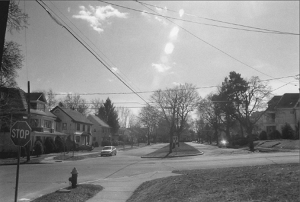Grandview Terrace Boulevard Historic District
- District Overview
- Inventory List
- Town:
- Hartford »
- Year of Establishment:
- 2001
- Overlapping Historic Designation(s):
- LHD, NRHD, SR
- District Authority:
- Historic Property Commission/ Historic Preservation Commission
- Link to Commission or Municipal Website:
- Map:
-
Map of the historic district retrieved from the Historic District Study Committee report, SHPO library, Hartford.
View photo - District Character:
- Urban Neighborhood
- Features:
Buildings
- Architectural Style:
Late 19th/20th Century revivals, Bungalow
- Era:
- 1900-1925 (Period of Significance)
- General description:
Grandview Terrace Boulevard Historic District is the block of Grandview Terrace in south Hartford that runs north and south between White Street and Linnmoore Street. Part of a 1900 real estate development, it is distinctive because it is the only block with a central median, making it a boulevard, because the lots are larger than those surrounding it, and because the 17 houses on the block, built between 1910 and 1925, are characteristic examples of contemporary architectural styles in a good state of historic preservation.
While the roadway of Grandview Terrace is flat running from White Street on the north to Linnmoore Street on the south, grade slopes up from the street to the west and down to the east, as the terrain is essentially a long sloping hillside. There are 17 houses on the block, nine on the west side and eight on the east. Twelve are two-family homes, five single-family. Fifteen are frame, one brick, and one stucco. All are designed in architectural styles in vogue during the first quarter of the 20th century. Stylistic features often are mixed in a single building. Roughly categorized, there are two houses in the Neo-Classical Revival style, four Colonial Revival, two Dutch Colonial Revival, six American Foursquare, one Federal Revival, and two Bungalows. Six are known to have been designed by architects. [NR]
- Significance of the district:
Architecture, Community Planning & Development:
Grandview Terrace Boulevard Historic District is significant historically because it was part, the most prestigious part, of an early-20th century "street-car suburb" real estate development that played a role in the rapid growth of Hartford at the turn of the 20th century. In this real estate development, which converted farmland to many small lots for affordable houses, the Boulevard District block was distinctive for its somewhat larger parcels suitable for more architecturally distinguished homes. The Grandview Terrace Boulevard Historic District is significant architecturally because builders took advantage of the subdivision plan to enhance this block with good examples displaying the characteristic features of contemporary architectural styles, including the Neo-Classical Revival, Colonial Revival, Dutch Colonial Revival, Federal Colonial Revival, American Foursquare, and Bungalow. [NR]
- District Boundary (according to the LHD Study Report, copied in 2010):
The district includes the properties facing Grandview Terrace on the Boulevard block between White and Linnmore Streets laid out in the 1900 real estate development plat, as described in the district ordinance.
- Sources:
[1] District information retrieved from the town website http://www.hartford.gov/.[2] Grandview Terrace Boulevard Historic District, Report of the Historic District Study Committee, SHPO Library, Hartford. [3] Assessors information and Parcel IDs retrieved from http://assessor1.hartford.gov/Default.asp?br=exp&vr=6.[NR] Ransom David F., Grandview Terrace Boulevard Historic District, National Register Nomination Number- 02001624 NRIS, National Park Service, 2002 - http://pdfhost.focus.nps.gov/docs/NRHP/Text/02001624.pdf; http://pdfhost.focus.nps.gov/docs/NRHP/Photos/02001624.pdf.
- Notes:
The local historic district and the National Register historic district are co-terminus.
- Disclaimer:
Content for this website and district boundaries were compiled from several sources and are subject to change. Boundaries for LHDs may be different from those of State or National Register Districts. To verify the boundaries and particulars of a specific district, consult the LHD study report on file with the respective municipal authority or the State Historic Preservation Office.
- Date of Compilation:
- 12/31/11
- Compiler:
- Manjusha Patnaik, CT Trust for Historic Preservation
